LIVIC – Laboratoire de recherche sur les Intéractions Véhicule - Infrastructure - Conducteur
INRETS – Institut National de Recherche sur les Transports et leur Sécurité
LCPC – Laboratoire Central des Ponts et Chaussées
Ministères Recherche & Transport
CANOpen Memento
Francis Dupin, November 2005
Version 1.2
I have put on this document some of the tips to test a node or to configure a CANOpen network.
If you do not know how works CANOpen, this document will not help you at all.
Feel free to redistribute this paper ... and to report the errors and missings to francis.dupin@inrets.fr
LIVIC – 14, route de la Minière. 78000 Versailles Satory. France
http://www.inrets.fr/ur/livic
1
�
The CAN message
id
rtr
do
d1
......
d7
Id : the CAN identifiant of the message. Usually on 11 bits.
rtr : 0 : normal message
1 : Remote Transmit Request message. Cannot contain data
dn : data byte. A normal message can contain 0 to 8 bytes of data
The CAN message in CANOpen
cobId
rtr
do
d1
......
d7
The data are put in CAN frame in lsb first (ie little endian).
Example : the number 0x01020304 should be embeded like this :
cobId
rtr
04
03
02
01
Fct code
4 bits 7 bits
0001
Fct Code (binary) : EMCY :
0011, 0100, 0101, 0110, 0111, 1000, 1001, 1010
PDO :
1011
SDOrx :
1100
SDOtx :
1110
NMT error control :
0000
NMT :
SYNC :
0001
TIME STAMP : 0010
Note : In this document,
- All the numbers are in hexadecimal notation.
- If not specified, the CAN messages are « normals » (rtr = 0)
LIVIC – 14, route de la Minière. 78000 Versailles Satory. France
http://www.inrets.fr/ur/livic
2
�
NMT protocol
To put a node in operational mode
To put a node in stop mode
000
0
01 nodeId
000
0
02 nodeId
To put a node in pre-operational mode
000
0
80 nodeId
To put a node in reset-application mode
000
0
81 nodeId
To put a node in reset-communication mode
000
0
82 nodeId
Note : To command all the nodes, use nodeId = 00
Examples
To put the node 0x6 in operational mode : 000 01 06
To put all the nodes in pre-operational mode : 000 80 00
LIVIC – 14, route de la Minière. 78000 Versailles Satory. France
http://www.inrets.fr/ur/livic
3
�
Node guard protocol
To ask for a node its state, the master sends :
The node responds :
700 +
nodeID
700 +
nodeID
1
0
t
state
One byte
t : toggle 0,1,0,1....
state : 4 = stopped
5 = operational
7F = pre-operational
Examples
To ask for the node 5 its state, the master sends a CAN request (rtr = 1) : 705
The node 5 which is in stopped mode responds : 705 05
The master sends a NMT to put the node in pre-operational mode : 000 80 05
The master sends a new CAN request : 705
The node 5 which is now in pre-operational mode responds : 705 FF because the toggle = 1
Heartbeat protocol
The node transmit cyclically its state, without the need of a request frame :
700 +
nodeID
0
0
state
One byte
state : 4 = stopped
5 = operational
7F = pre-operational
Examples
The node 5, in pre-operational mode sends cyclically : 705 7F
Beware : There is no toggle bit.
Bootup protocol
When a node enters in pre-operational mode after being in initializing mode, it sends :
700 +
nodeID
0
00
LIVIC – 14, route de la Minière. 78000 Versailles Satory. France
http://www.inrets.fr/ur/livic
4
�
SDO protocol
SDO are used to read or write to the object dictionary of a node.
The node which request a read or a write is the client node.
The node in which the data is read or written is the server node.
Read = upload protocol
Write = download protocol
To read or write a data of 4 bytes or less, the simplest way is to use the
SDO upload/download expedited protocol.
All the SDO have the same CAN frame length : 8 bytes of data and rtr = 0.
SDO Download expedited protocol
To write the data 0xd0d1... in the server node object dictionary, the client node sends :
Data length = 1 byte
Data length = 2 bytes
Data length = 3 bytes
Data length = 4 bytes
The client request :
600 + Serv
NodeId
0
2F
The client request :
600 + Serv
NodeId
0
2B
The client request :
The client request :
600 + Serv
NodeId
0
27
The client request :
600 + Serv
NodeId
0
23
Index
Sub
index
d0
x
x
x
X : undefined. Put 0
Index
Sub
index
d1
d0
x
x
X : undefined. Put 0
Index
Sub
index
d2
d1
d0
x
X : undefined. Put 0
Index
Sub
index
d3
d2
d1
d0
The server responds (if success) :
580 + Serv
NodeId
0
60
Index
Sub
index
00
00
00
00
The server responds (if failure) :
580 + Serv
NodeId
0
80
Index
Sub
index
SDO abort code error
Examples
To write the 1 byte data : 0xFD in the object dictionary of node 5, at index 0x1400, subindex 2, sends :
605 2F 00 14 02 FD 00 00 00
If success, the node 5 responds :
585 60 00 14 02 00 00 00 00
To write the 4 bytes data : 0x60120208 in the object dictionary of node 5, at index 0x1603, subindex 1, sends :
605 23 03 16 01 08 02 12 60
If success, the node 5 responds :
585 60 03 16 01 00 00 00 00
LIVIC – 14, route de la Minière. 78000 Versailles Satory. France
http://www.inrets.fr/ur/livic
5
�
SDO Upload expedited protocol
To read the data 0xd0d1... in the server node object dictionary, the client node sends :
The client request :
600 + Serv
NodeId
0
40
Index
Sub
index
00
00
00
00
The server responds (if success) :
Data length = 1 byte
580 + Serv
NodeId
0
4F
Index
Sub
index
d1
x
x
x
The server responds (if success) :
X : undefined. Should be 0
Data length = 2 bytes
580 + Serv
NodeId
0
4B
Index
Sub
index
d1
d0
x
x
The server responds (if success) :
X : undefined. Should be 0
Data length = 3 bytes
580 + Serv
NodeId
0
47
Index
Sub
index
d2
d1
d0
x
The server responds (if success) :
X : undefined. Sould be 0
Data length = 4 bytes
580 + Serv
NodeId
0
43
Index
Sub
index
d3
d2
d1
d0
The server responds (if failure) :
580 + Serv
NodeId
0
80
Index
Sub
index
SDO abort code error
Examples
To read the 1 byte data : 0xFD in the object dictionary of node 5, at index 0x1400, subindex 2, sends :
605 40 00 14 02 00 00 00 00
If success, the node 5 responds :
585 4F 00 14 02 FD 00 00 00
To read the 4 bytes data : 0x60120208 in the object dictionary of node 5, at index 0x1603, subindex 1, sends :
605 40 03 16 01 00 00 00 00
If success, the node 5 responds :
585 43 03 16 01 08 02 12 60
LIVIC – 14, route de la Minière. 78000 Versailles Satory. France
http://www.inrets.fr/ur/livic
6
�
SDO abort protocol
Abort code (hexa)
0503 0000
0504 0000
0504 0001
0504 0002
0504 0003
0504 0004
0504 0005
0601 0000
0601 0001
0601 0002
0602 0000
0604 0041
0604 0042
0604 0043
0604 0047
0606 0000
0607 0010
0607 0012
0607 0013
0609 0011
0609 0030
0609 0031
0609 0032
0609 0036
0800 0000
0800 0020
0800 0021
0800 0022
0800 0023
Toggle bit not alternated
SDO protocol timed out
Client/server command specifier not valid or unknown
Invalid block size (block mode only)
Invalid sequence number (block mode only)
CRC error (block mode only)
Out of memory
Unsupported access to an object
Attempt to read a write only object
Attempt to write a read only object
Object does not exist in the object dictionary
Object cannot be mapped to the PDO
The number and length of the objects to be mapped whould exeed PDO length
General parameter incompatibility reason
General internal incompatibility in the device
Access failed due to a hardware error
Data type does not match, length of service parameter does not match
Data type does not match, length of service parameter too hight
Data type does not match, length of service parameter too low
Sub-index does not exist.
Value range of parameter exceeded (only for write access)
Value of parameter written too hight
Value of parameter written too low
Maximum value is less than minimum value
General error
Data cannot be transferred or stored to the application
Data cannot be transferred or stored to the application because of local control
Data cannot be transferred or stored to the application because ofthe present device state
Object dictionary dynamic generation fails or no object dictionary is present.
LIVIC – 14, route de la Minière. 78000 Versailles Satory. France
http://www.inrets.fr/ur/livic
7
�
How to configure a PDO Transmit ?
Example :
- Configuring the PDO 0x1800 + n
- Its cobId must be 0x387 (why not ?)
- The PDO is transmitted on synchro
- It must contains the data : data X (2 bytes) and data Y (4 bytes) in this order
- dataX is defined at index 0x6000 subindex 03
- dataY is defined at index 0x2010 subindex 21
1 – Index 1800 + n, subindex 01 : write the cobId (4 bytes)
2 – subindex 02 : write the transmission type « t » (1 byte)
t = 1 to 0xF0 : The PDO is transmitted every reception of « t » SYNC
t = FD : Transmission after reception of a request PDO (rtr = 1)
t = FF : Transmission on event. The nodes sends the PDO spontaneously
3 – Index 1A00 + n : define the mapping of the nth data.
Subindex 0 : write the number of data embeded in the PDO (1 byte). For this example, write « 2 »
Subindex 1 : define where to find the first data embeded and the size. (8 bytes)
The format is : index (2 bytes) – subindex (1 byte) – size in bits (1 byte)
For this example, write « 60000308 »
Subindex 2 : define where to find the second data embeded an the size (8 bytes)
For this example, write « 20102120
To configure the PDO 1802 of the node 5 to be transmitted every 3 synchro,
the SDO(s) to send should be (I have not tested) :
605 23 02 18 01 00 00 07 38
605 2F 02 18 02 03 00 00 00
605 2F 02 1A 00 02 00 00 00
605 23 02 1A 01 08 03 00 60
605 23 02 1A 02 20 21 10 10
The PDO :
387
0
dataX
dataY
Note : a PDO may contains less than 8 bytes of data.
What is a PDO Transmited « on request » ?
It is a PDO which must be transmited when the node is receiving a remote transmit request (rtr) with the same COBID
than the PDO.
Example :
PDO request :
384
1
If the PDO with the COBID 384 is « on request », it must be transmited.
LIVIC – 14, route de la Minière. 78000 Versailles Satory. France
http://www.inrets.fr/ur/livic
8
�
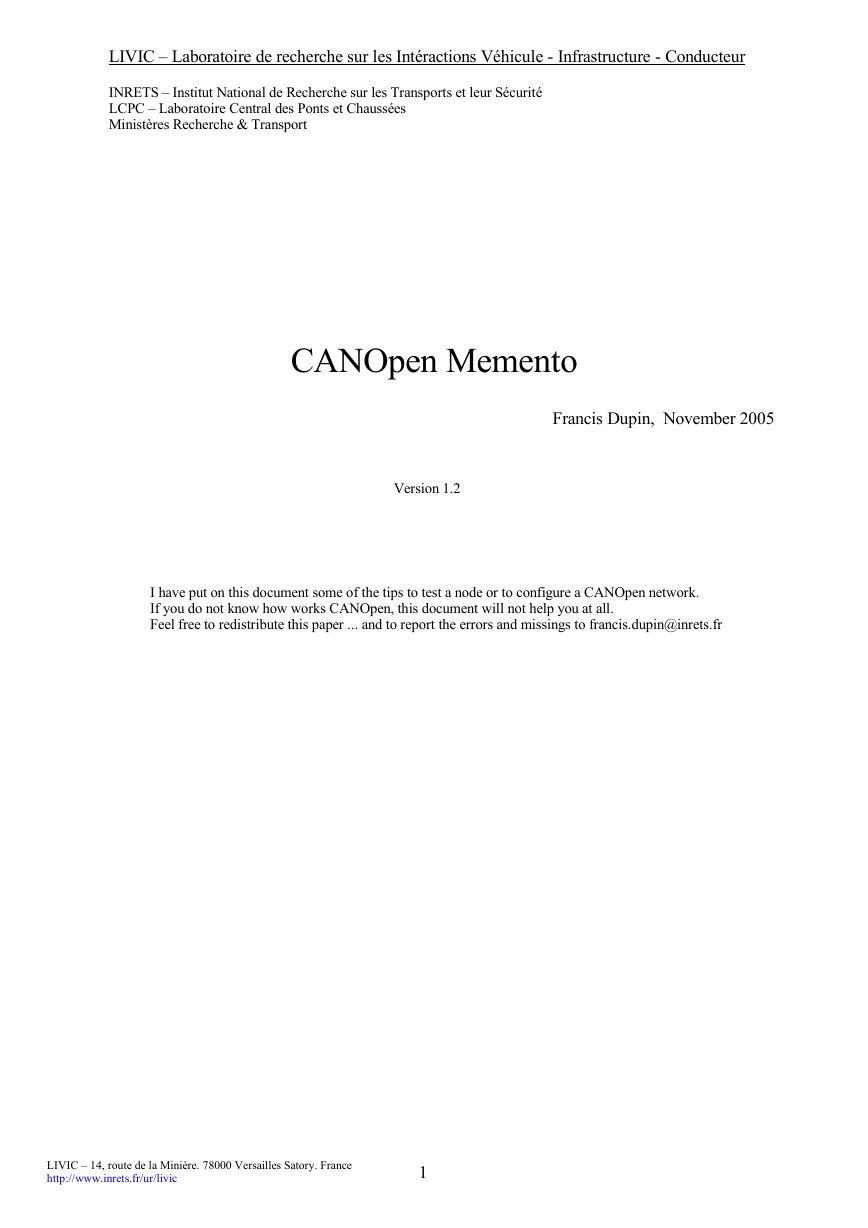
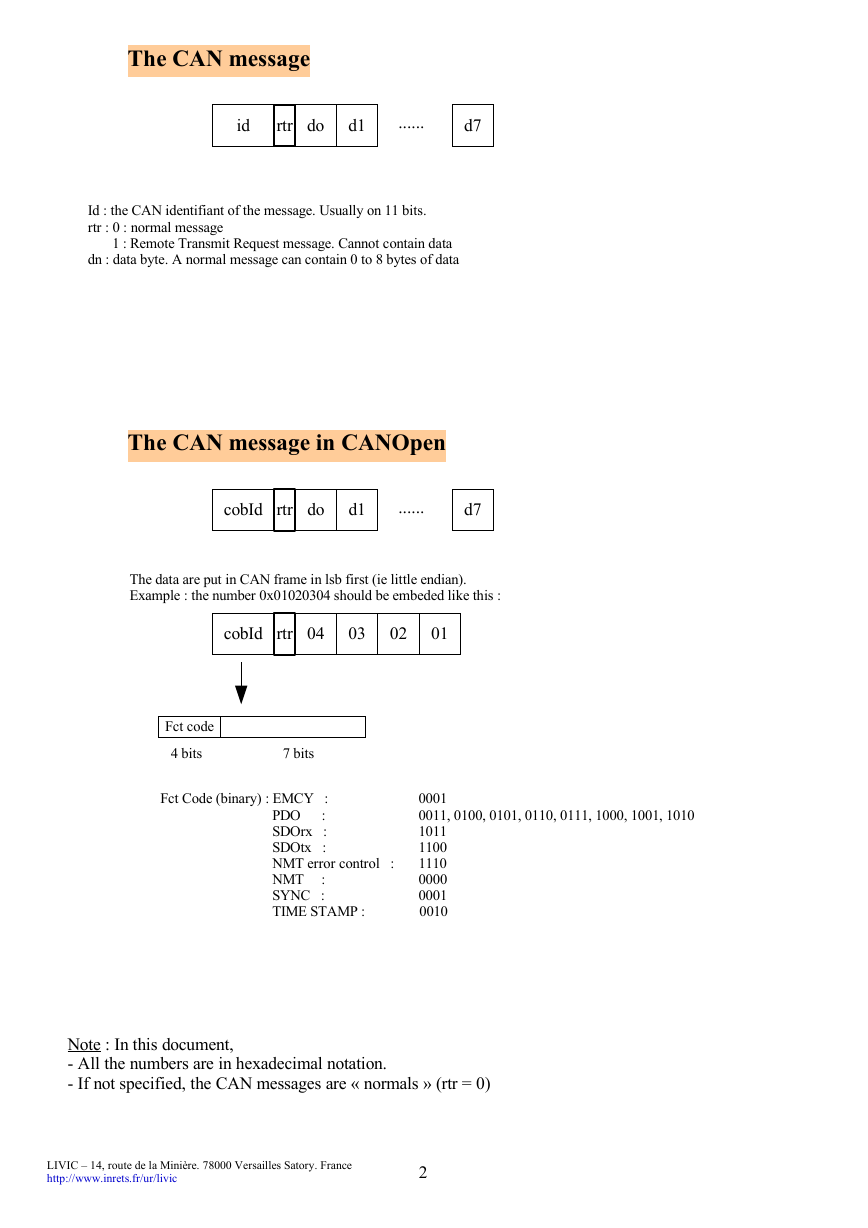
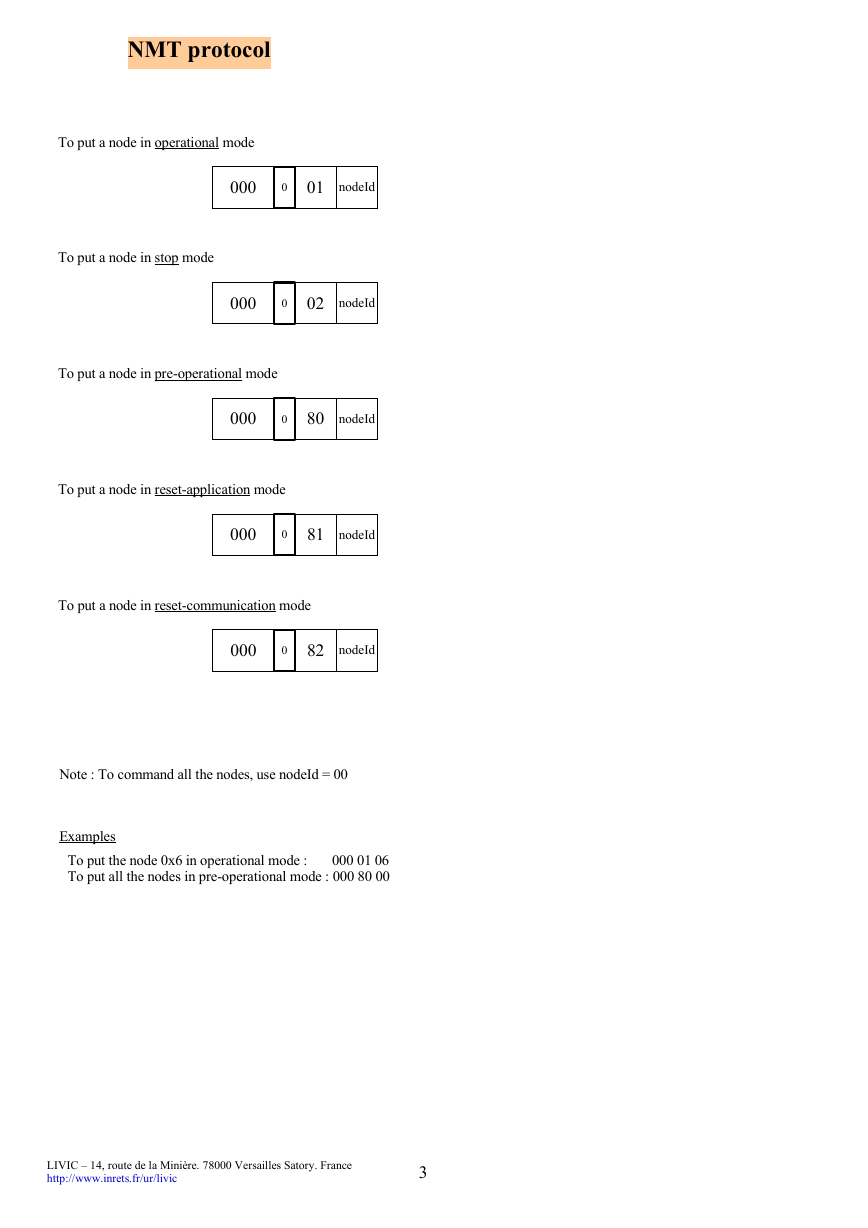

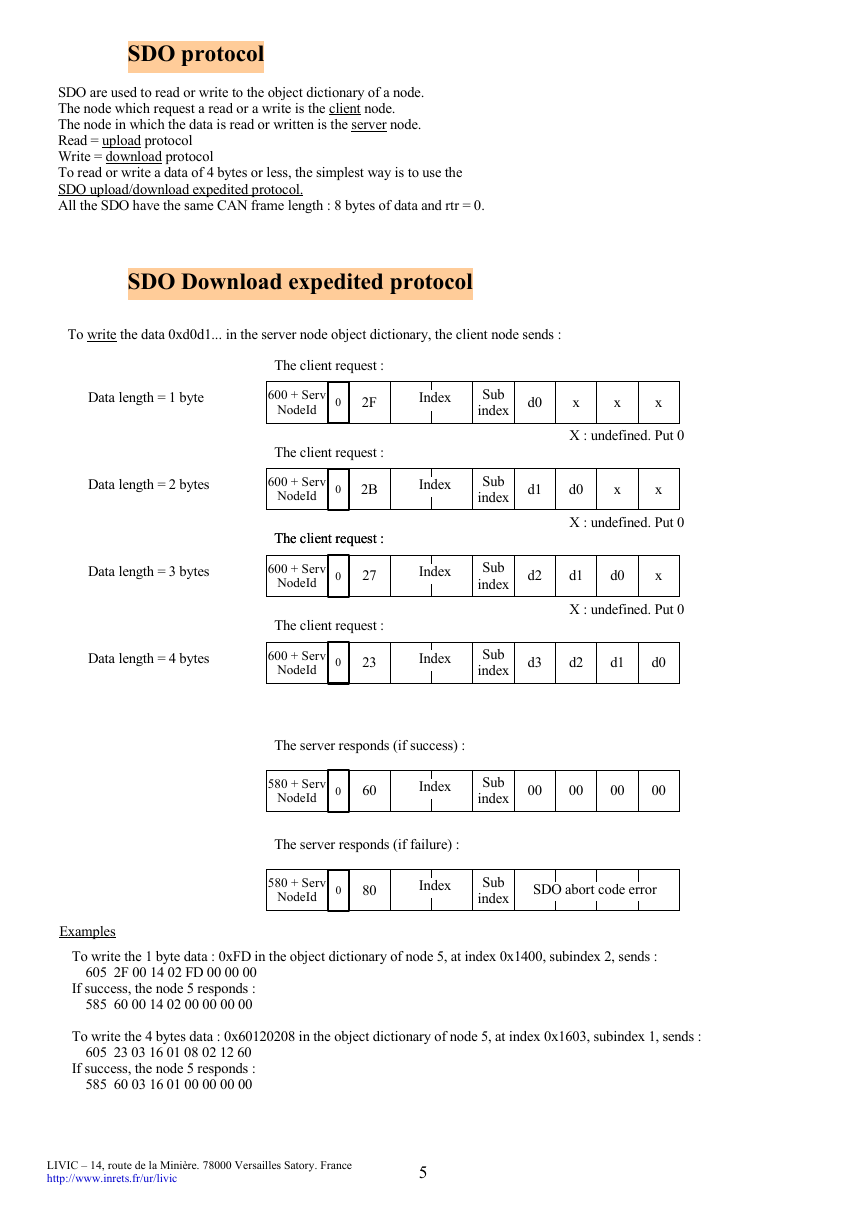
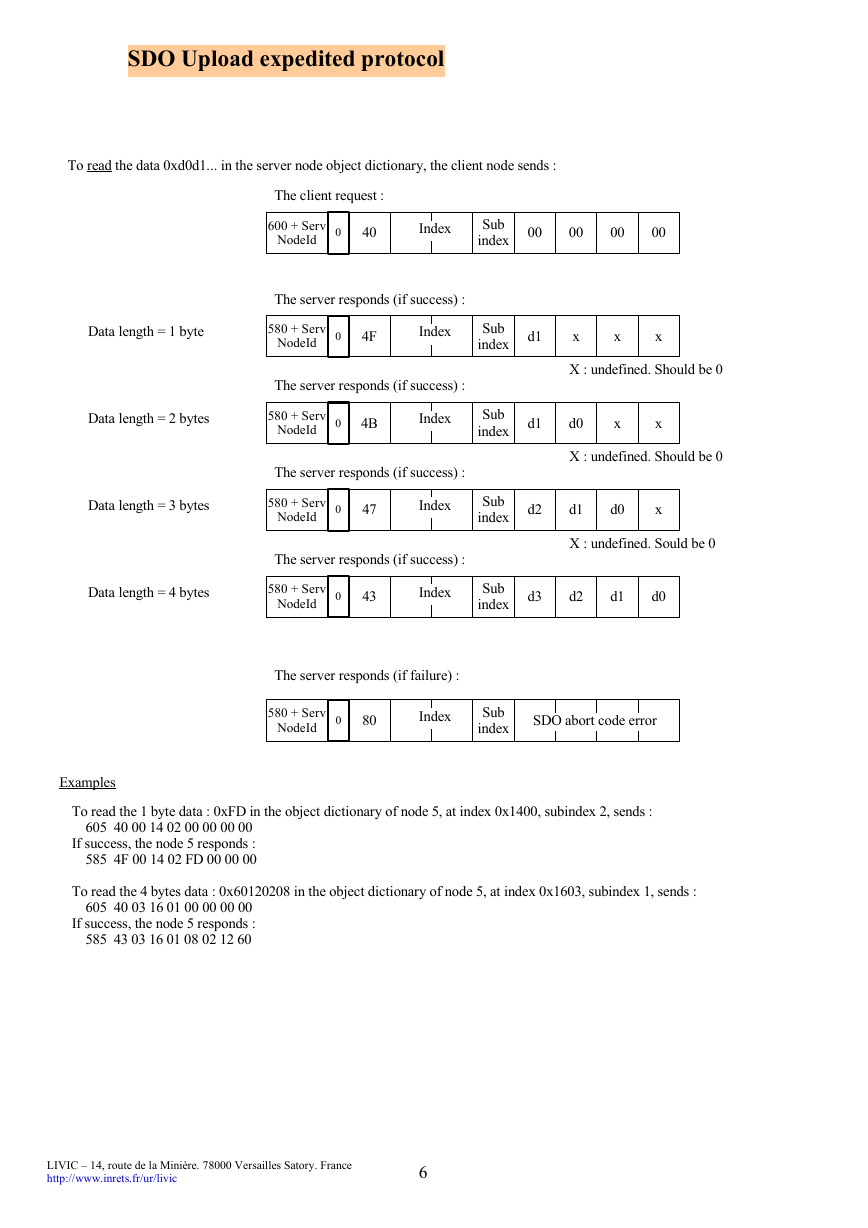

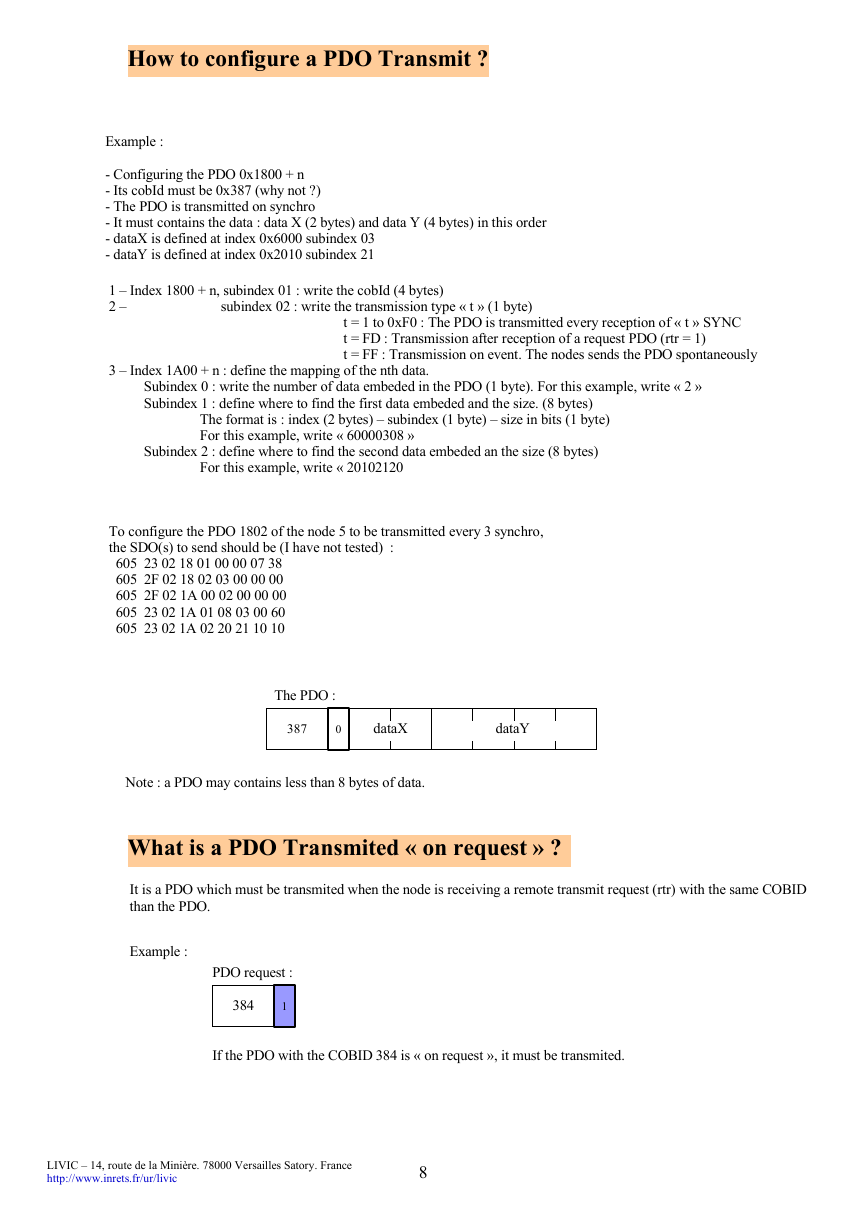








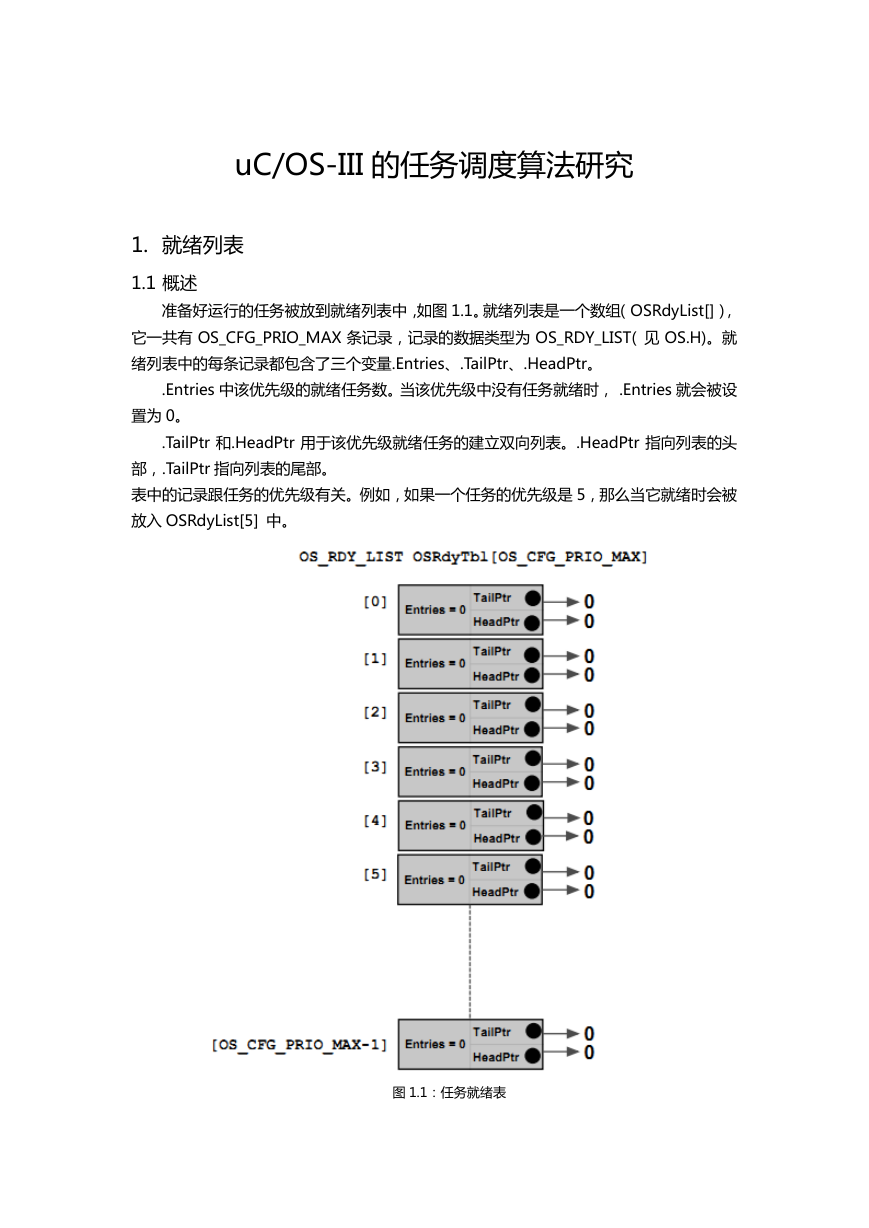 uCOS-III的任务调度算法研究.pdf
uCOS-III的任务调度算法研究.pdf STM32F103x8B_DS_CH_V10(7STM32中文数据手册).pdf
STM32F103x8B_DS_CH_V10(7STM32中文数据手册).pdf FX2N系列PLC培训教程.pdf
FX2N系列PLC培训教程.pdf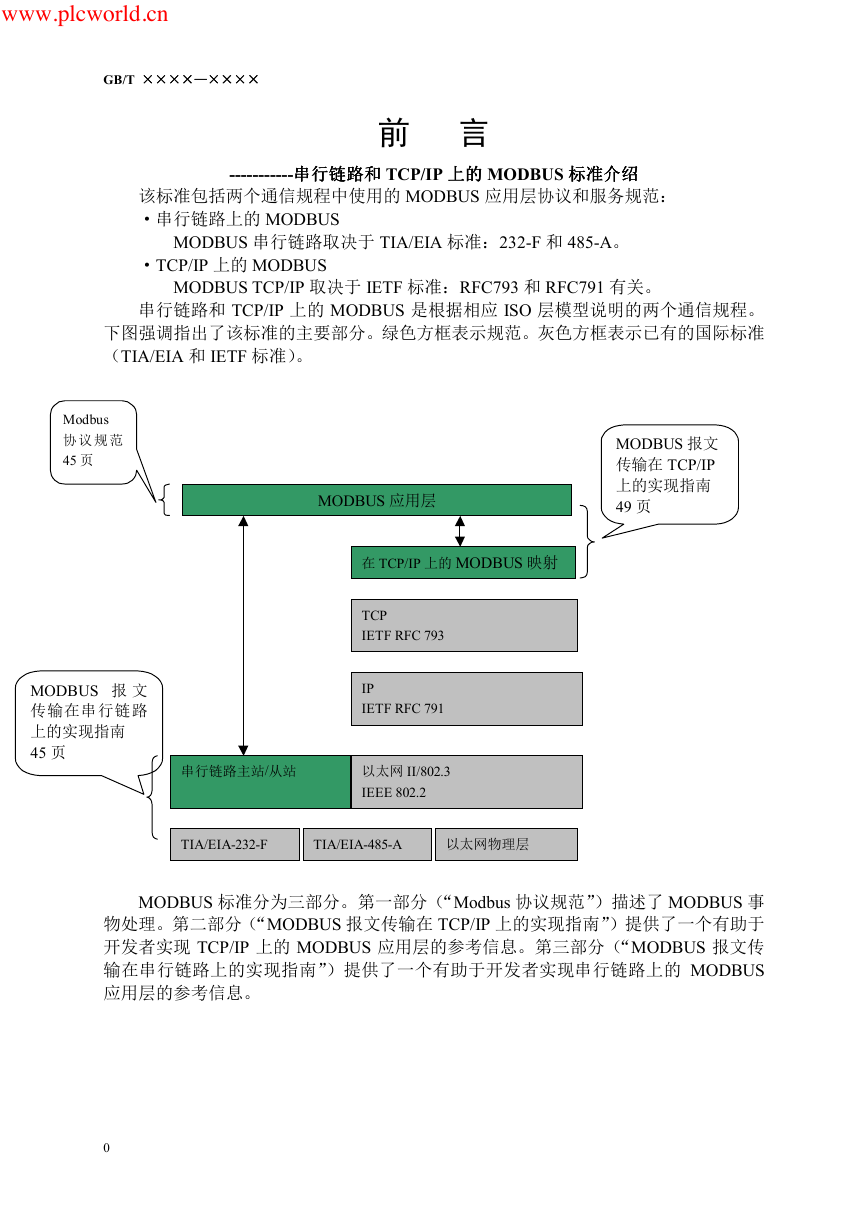 Modbus协议资料.pdf
Modbus协议资料.pdf WM8978中文资料(芯片资料).doc
WM8978中文资料(芯片资料).doc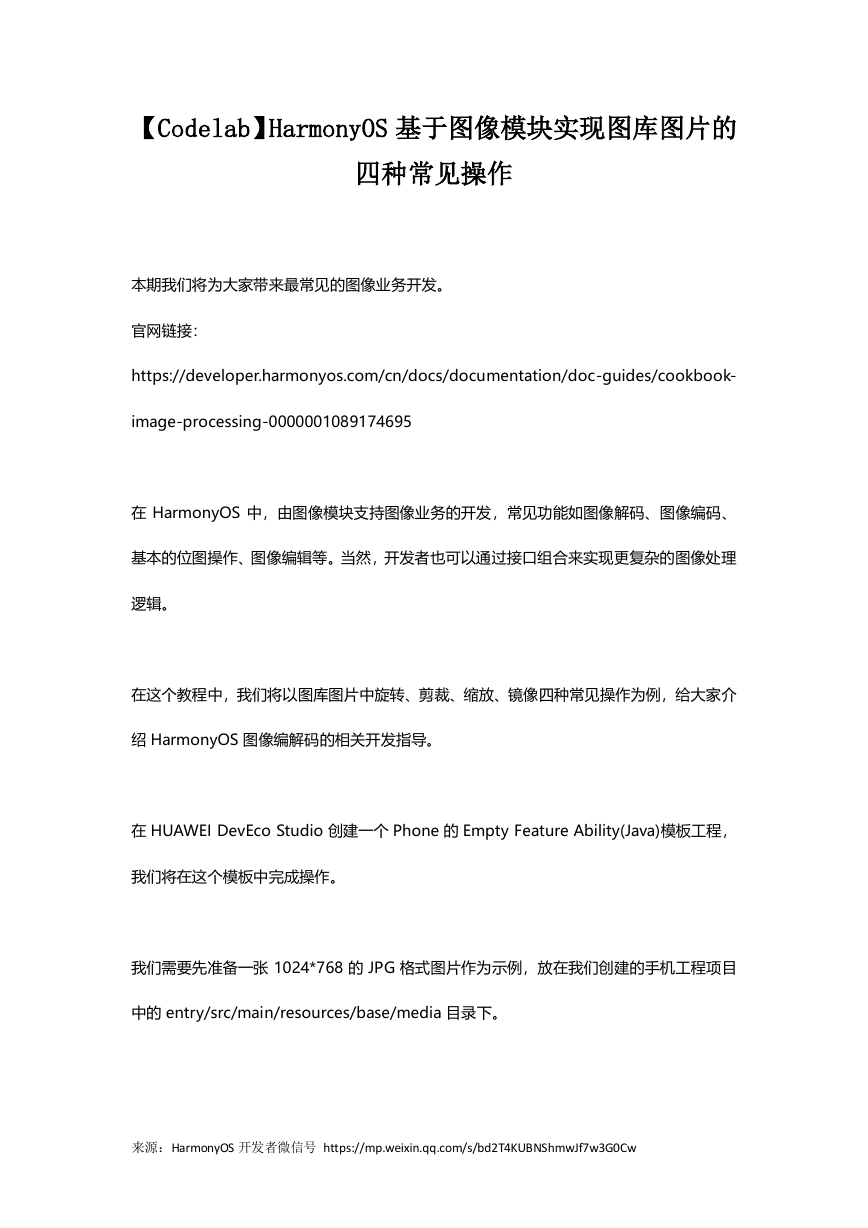 5-1.【Codelab】HarmonyOS基于图像模块实现图库图片的四种常见操作.pdf
5-1.【Codelab】HarmonyOS基于图像模块实现图库图片的四种常见操作.pdf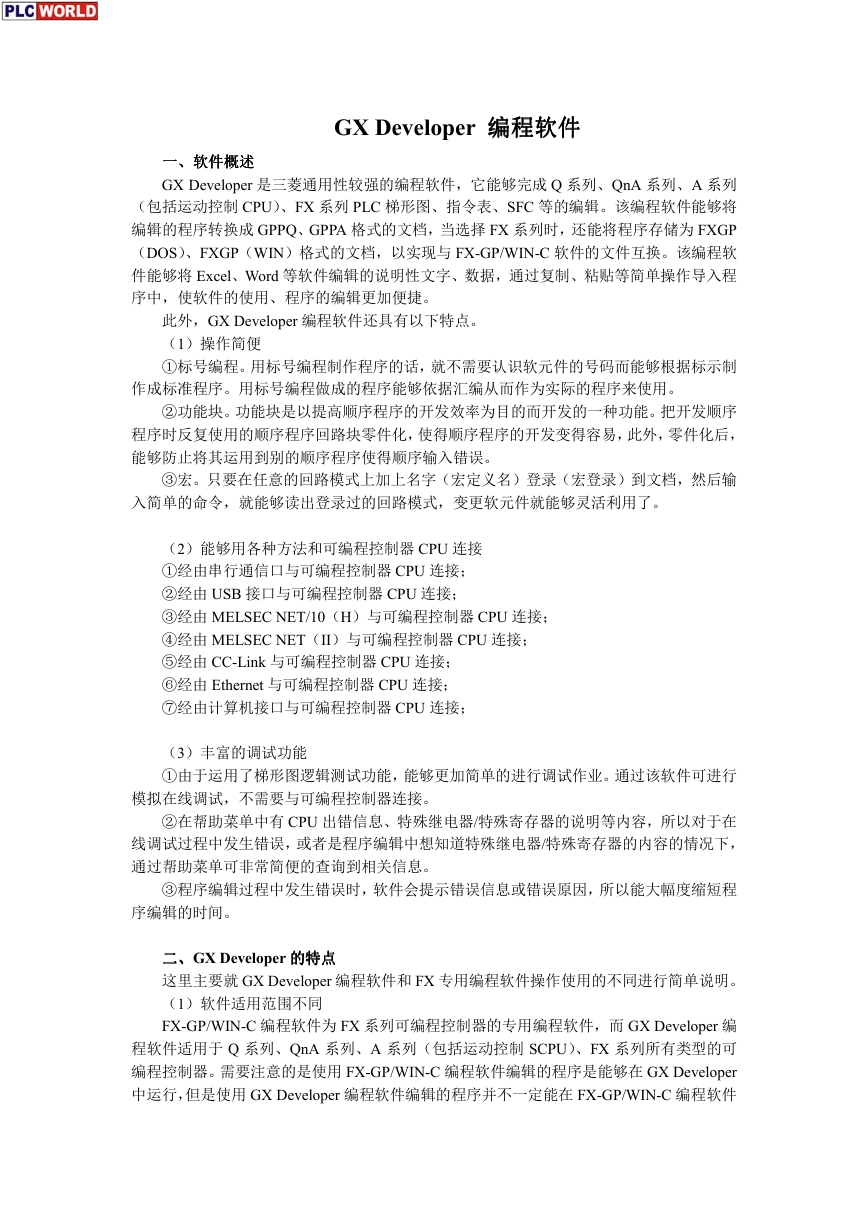 GX Developer 编程软件使用说明.pdf
GX Developer 编程软件使用说明.pdf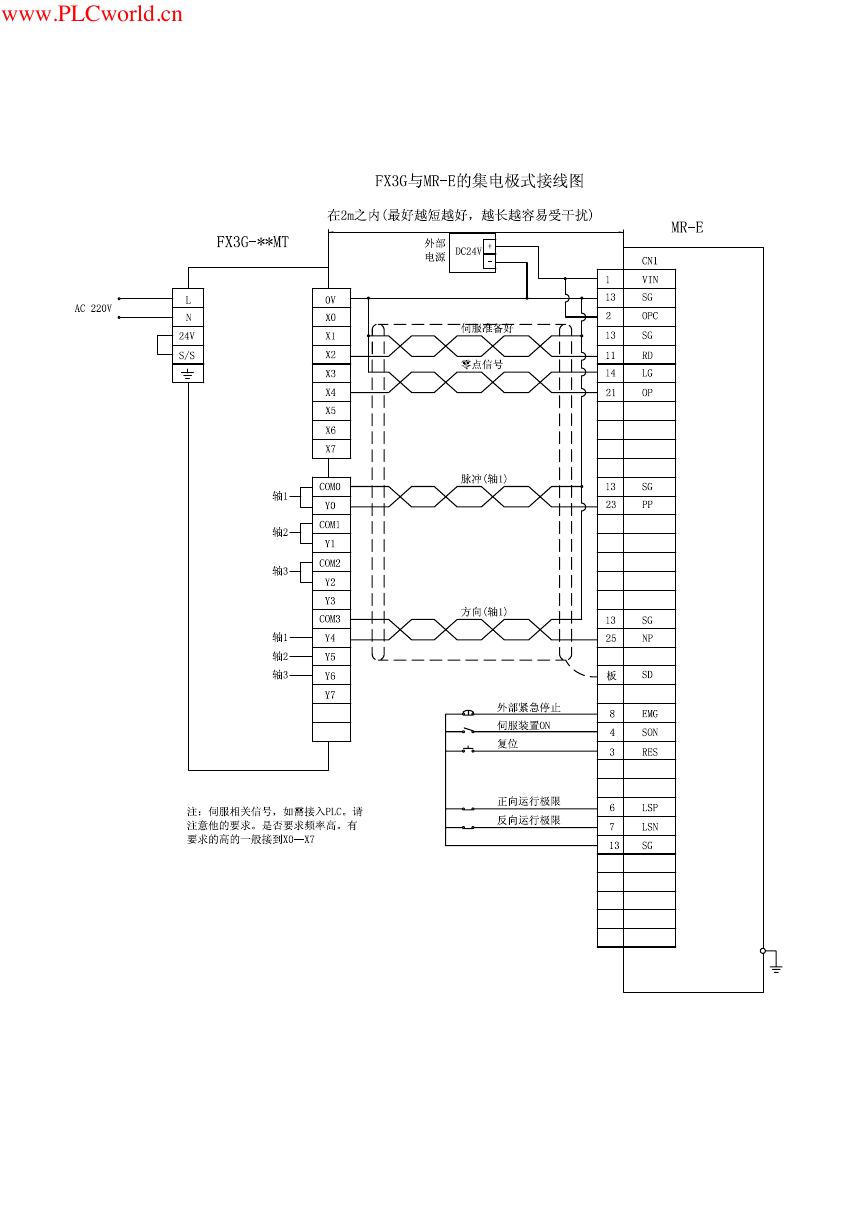 MR-E伺服与FX3G接线图.pdf
MR-E伺服与FX3G接线图.pdf ATK-NEO-6M GPS模块常见问题汇总_201400721.pdf
ATK-NEO-6M GPS模块常见问题汇总_201400721.pdf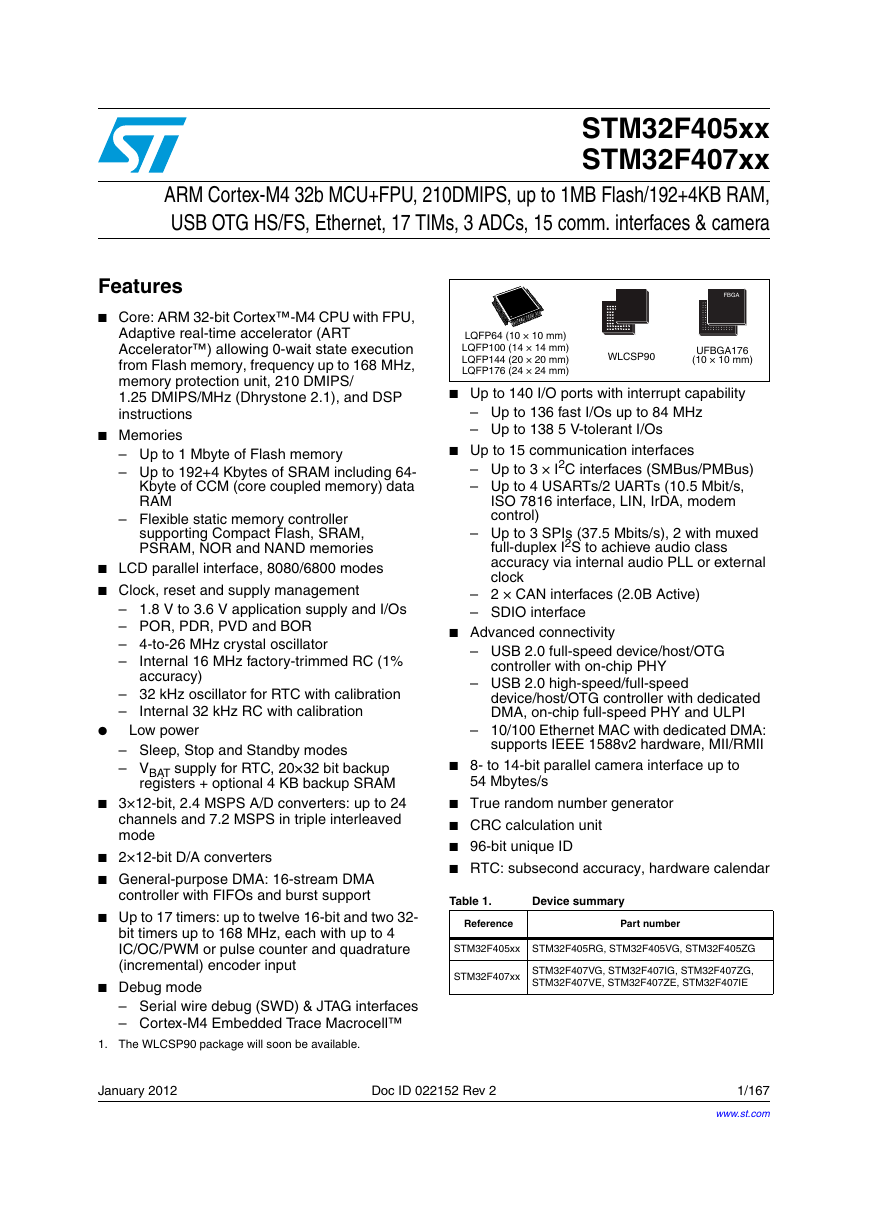 STM32F407ZGT6(芯片资料).pdf
STM32F407ZGT6(芯片资料).pdf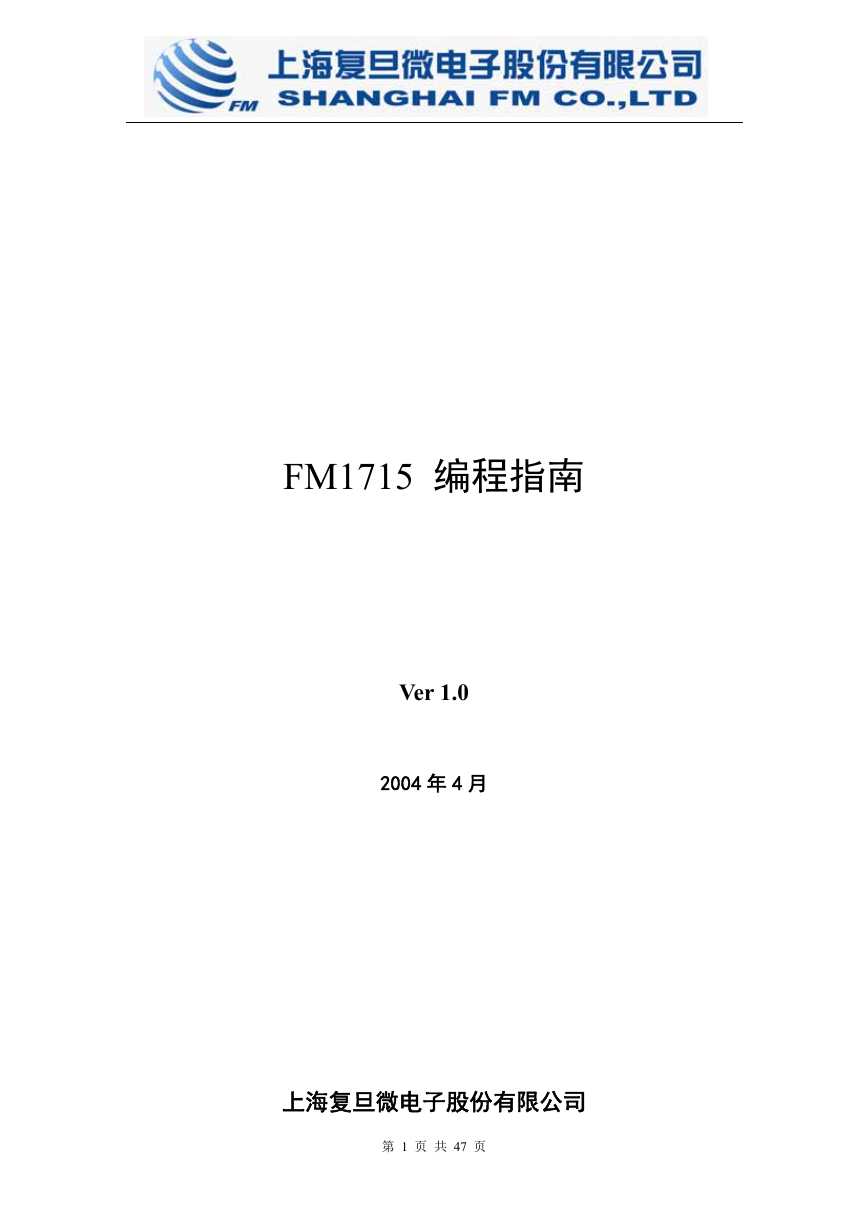 FM1715编程指南.pdf
FM1715编程指南.pdf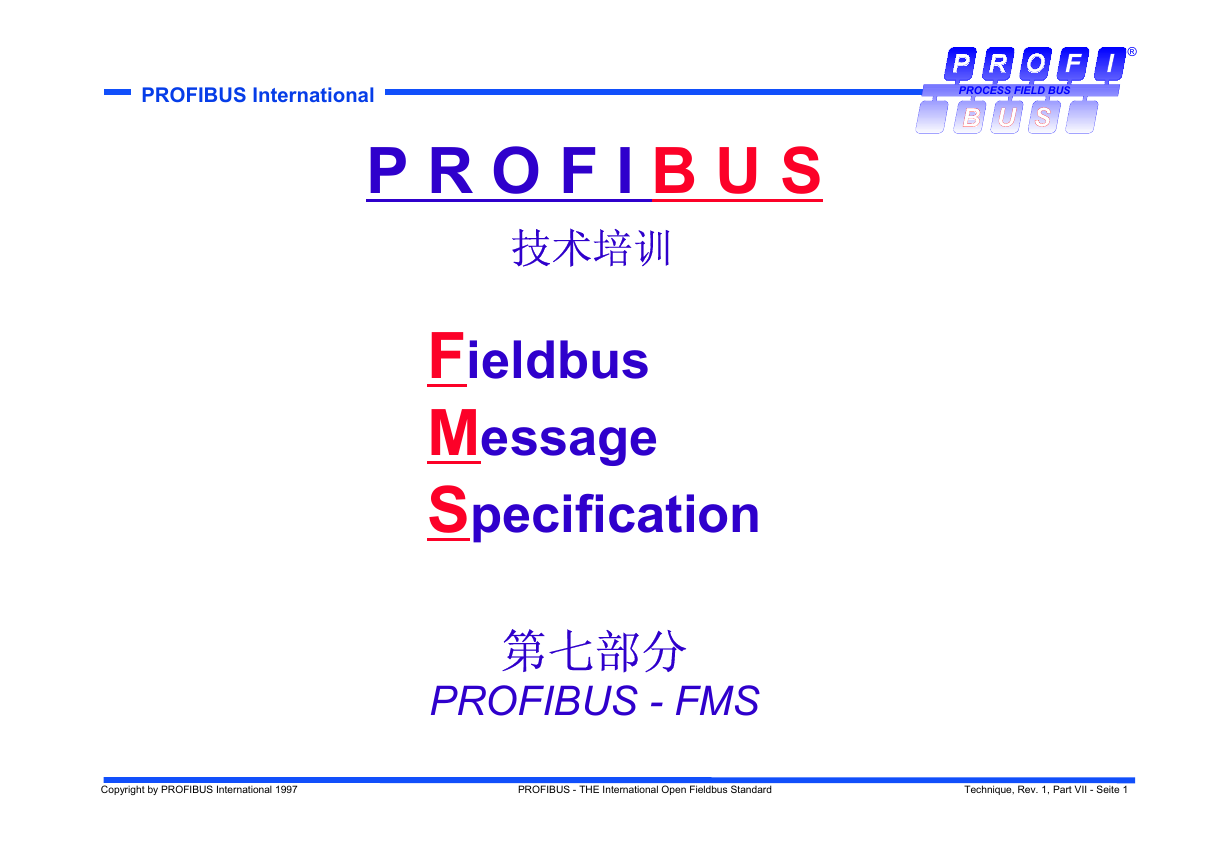 Profibus教程-7.PROFIBUS-FMS.pdf
Profibus教程-7.PROFIBUS-FMS.pdf